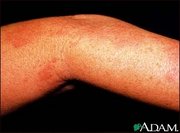A new vaccine has prevented half the cases of shingles in elderly people participating in a trial. When the painful disease did appear, it was generally less severe and cleared up faster than it did in study participants who got an inert shot.
The findings could pave the way for regulatory approval of the experimental vaccine. "I wouldn't hesitate to give it to anyone over 60," says study coauthor Michael N. Oxman, a virologist at the Veterans Affairs San Diego Healthcare System and the University of California, San Diego. People with compromised immunity might have to receive smaller vaccine doses than those given in the experiment, says Oxman, who himself received the shot in a preliminary test of the vaccine.
For the moment, the vaccine is called the live attenuated Oka/Merck VZV by its maker, Merck & Co. of Whitehouse Station, N.J.
Shingles is the old-age aftershock of chicken pox. Both diseases arise from a single virus, varicella-zoster. Children who contract the virus routinely recover from chicken pox but harbor the virus in their nervous systems. In adulthood, for reasons still unclear, the virus can awaken as shingles, also called herpes zoster.
Symptoms of shingles include a rash on the face or trunk accompanied by a combination of numbness, itching, and pain that can last months
or longer. Antiviral treatments can offer some relief.
In the study, doctors at 22 medical centers enrolled more than 38,000 people over age 59, randomly assigning half to receive the vaccine and half to get a placebo. Over 3 years, 642 of the placebo recipients but only 315 of the vaccinated group developed shingles, Oxman and his colleagues report in the June 2 New England Journal of Medicine.
Vaccination also cut by two-thirds the number of people who developed postherpetic neuralgia, a complication of shingles in which pain lingers after the rash heals.
Doctors began immunizing children against chicken pox in 1995, but that vaccine doesn't prevent shingles later in life because even the weakened virus used in the vaccine can hide in nerves. However, virus from a chicken pox vaccination would probably produce only a mild case of shingles, Oxman says.
While the chicken pox vaccine stirs production of antibodies, the shingles, or zoster, vaccine triggers immune system T cells that thwart shingles. But how these cells accomplish this feat is poorly understood, Oxman says.
Several generations of middle-aged and older people who had chicken pox as youths would benefit from the new vaccine, says Donald H. Gilden, a neurologist at the University of Colorado Health Sciences Center in Denver.
"I'm in favor of getting the vaccine marketed," he says. If its protection wanes over time, a booster might be needed, he says.
The rare person who's had neither chicken pox nor chicken pox immunization won't get shingles and shouldn't get this new vaccine, Gilden says. Shingles strikes about 500,000 people in the United States each year, most over the age of 50.
COPYRIGHT 2005 Science Service, Inc.
COPYRIGHT 2005 Gale Group



